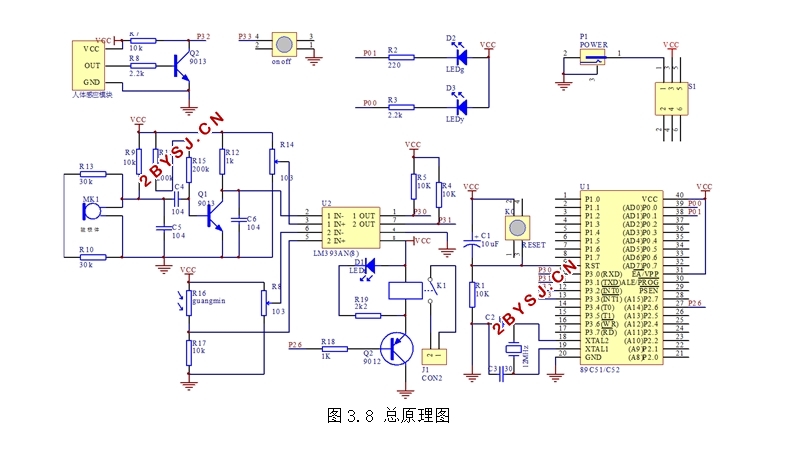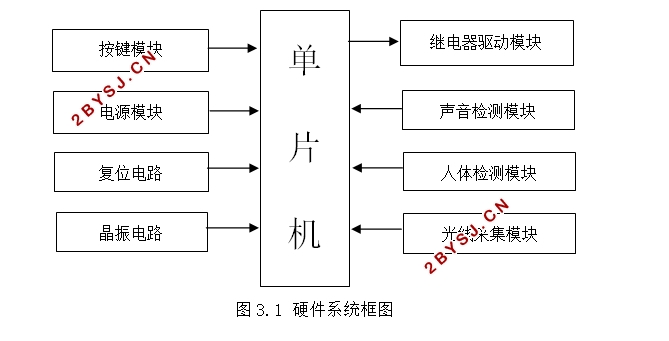基于单片机的声光及红外检测系统设计
无需注册登录,支付后按照提示操作即可获取该资料.
基于单片机的声光及红外检测系统设计(开题报告,外文翻译,论文11600字)
摘要
社会逐渐发展,科技日新月异,很多身边习以为常的事物都得到了改善,过时、不环保、不节能的产品将逐渐被淘汰。随着社会的潮流更替,迫切需要在现有路灯的基础上设计出更加环保更加节能同时又更加方便我们使用的新型声光红外检测系统。
本次设计以AT89C51单片机为核心,通过声音采集模块、光线采集模块以及人体感应模块,配合以系统软硬件设计,来实现本设计的功能。设计过程中,采用驻极体对声音信号的采集,光线采集模块采集光线,热释电红外感应模块对人体的检测,使系统在白天即使检测到声音继电器也不吸合;而光线不足时,检测到声音使继电器吸合从而负载的小灯泡点亮;热释电模块感应人体,当光线不足时,检测到有人靠近也使继电器吸合负载灯泡点亮。
关键词:单片机 声音采集 光线采集 人体感应
The Design of a sound-light and infrared detection system based on Microcontroller
Abstract
With the development of the society, science and technology advances, quality of people’s lives is being improved as well. Eco-friendly products are being much more popular nowadays. Amount of outdated, environmental damage, energy-efficient products have been replaced by eco-friendly products. To follow the step of the development, we are going to design a kind of infrared light which is based on the existing street lights, but much more environmental and energy-efficient.
AT89C51 microcontroller is the core of the revolution. By gathering sound, light and human body sensor, the system will work under the combination of modules and various hardware and software. The theory of the design is by using an electret sound signal acquisition, the light collection module light and pyroelectric infrared sensor module detects the human body, the system detected during the daytime even if the relay is not energized sound. When the sunlight is being weaker, then the sound will be detected. The relay lit light bulb so that the load; pyroelectric sensor module acting on the body, when there is insufficient light, detects someone close also relay then the lamp is on.
Key Words: Microcontroller; sound acquisition module; light gathering module; human body sensing module



目录
摘要 I
Abstract II
目录 III
第一章 绪 论 1
1.1 课题背景 1
1.2 设计思路 2
1.3 本文所做的工作 2
第二章 系统设计概述 4
2.1 系统的设计内容 4
2.2 系统的方案选择 5
2.2.1 声音采集设计方案 5
2.2.2 光线采集设计方案 5
2.2.3 人体检测设计方案 6
第三章 硬件系统设计 8
3.1 硬件系统框图 8
3.2 单片机最小系统 8
3.2.1 复位电路 9
3.2.2 晶振电路 10
3.3 声音采集模块 10
3.4 光线采集模块 11
3.5 热释电模块 13
3.6 电压比较器模块 14
3.7 继电器驱动模块 15
3.8 系统原理图 16
第四章 软件设计 18
4.1 程序设计步骤 18
4.2 程序流程图 19
4.3 光线采集程序 21
4.4 声音采集程序 22
4.5 人体检测程序 23
第五章 系统调试 24
结束语 27
参考文献 28
致谢 29
